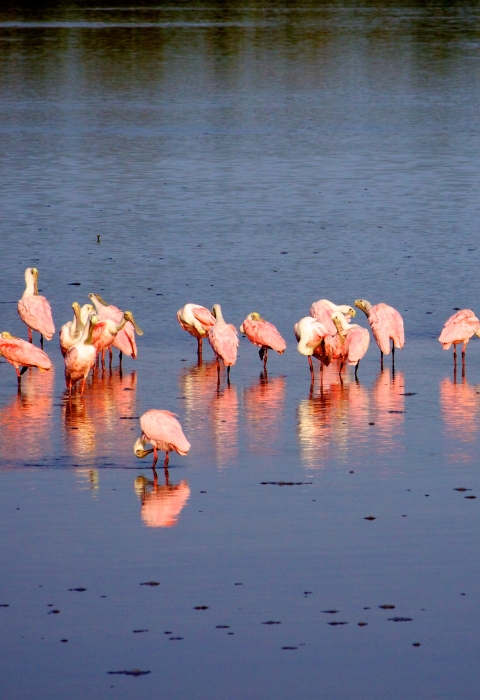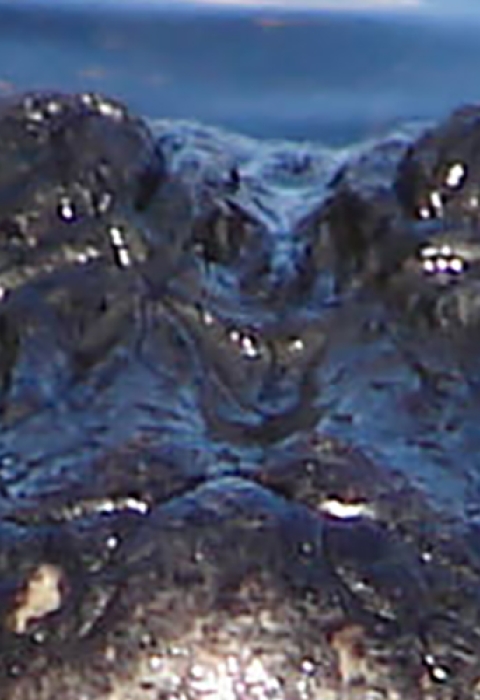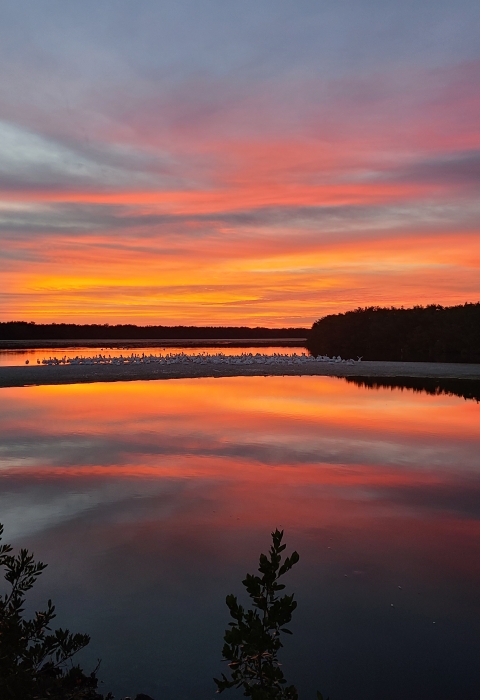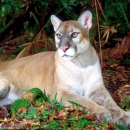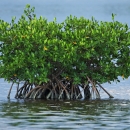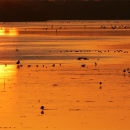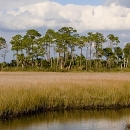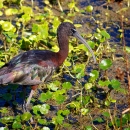Visit Us
The best place to start your visit is the FREE Visitor & Education Center!
It is open from 9am to 4pm and parking is FREE. America’s Best Restrooms and water bottle filling stations are located just around the corner to the right of the main doors. The center is accessible and is full of educational displays, videos, interactive programs. Stop by the information desk, where staff and volunteers are available to answer all your questions. Finally, don’t forget to shop in the Nature Store to support! Please note the Visitor and Education center and administration buildings are closed on Fridays and all federal holidays.
Wildlife Drive is open every day, EXCEPT FRIDAYS, all year regardless of the holidays. All visitor must exit refuge lands no later than 30 minutes after legal sunset. The Wildlife Drive is a four mile, one way road, with a speed limit of 15 miles per hour. The road is open to pedestrians, bicyclist, cars, or you can sign up with Tarpon Bay Explorers to take a guided 90 minute tram tour. When driving, vehicle can pull over and park on the right side on the road to explore our trails, overlooks, and observation tower.
The best time to visit is during LOW TIDE! Check the tide charts in the Visitor and Education center or click here to see when the tide will be low along the drive.
Florida is HOT! Make sure to bring plenty of water, sunscreen, hat, bug spray, and wear comfortable walking shoes to ensure your safety while enjoying the refuge.
Speed limits are STRICTLY ENFORCED! To ensure the safety of everyone, we ask that you please follow all speed limit signs and safety instructions and wear your seatbelts. While engulfed in nature, many people are not aware of their surroundings so please pay attention to what is around you.
Dogs are permitted on Wildlife Drive, Indigo Trail, and the Bailey Tract as long as they are kept on a leash no longer than six feet and under control at all times.
Visit the Refuge's official concessionaire, Tarpon Bay Explorers located two miles from the Visitor & Education Center for more opportunities to get on the water.
Activities
There is plenty to do here at J.N. "Ding" Darling National Wildlife Refuge!
Trails
Indigo Trail and the Wildlife Education Boardwalk, Calusa Shell Mound Trail and Wulfert Keys Trail can all be accessed through Wildlife Drive. Bailey tract is located off Tarpon Bay Rd, 3.0 miles from the Visitor and Education Center.
Indigo Trail is a 4-mile, round trip trail that leaves from the Visitor and Education Center parking lot and ends at the Cross Dike, which extends from the Wildlife Drive. Along the Indigo Trail, visitor often spot wildlife such as alligators, night-herons or white ibises. The Indigo Trail is CLOSED FRIDAYS ONLY. The boardwalk leading from the Visitor and Education Center to the Fee Booth is CLOSED. To access the Indigo Trail, go down Wildlife Drive and turn left at the fee booth.
3/10 of a mile from the Visitor and Education center, on the Indigo trail, the Wildlife and Education Boardwalk (WEB) interprets wildlife scat, tracts and gives a great view of the freshwater area where alligators, and seasonally, nesting birds can be viewed over the water with a two-story observation pavilion.
Wulfert Keys Trail off the Wildlife Drive is a short 1/3-mile-long trail which follows a power line access to Pine Island Sound. Here, visitors will get a spectacular view of the sound and may see brown pelicans, osprey or even manatee.
Calusa Shell Mound Trail (CLOSED) is a 1/3-mile-long loop accessible interpretive boardwalk that is located near the end of the wildlife drive. The trail meanders through a hardwood hammock that has grown on top of an ancient Calusa Shell Mound. Visitors will lean about the ancient indigenous people of the area, as well as the unique hammock environment while reading interpretive panels. This is an excellent place to spot warblers and other migratory songbirds during the spring and fall migrations.
Located off Tarpon Bay Road, the FREE Bailey Tract is a unique area of the refuge. This 100-acre parcel is an interior wetland where freshwater plants and wildlife dominate. The trails can be accessed by walking or biking from sunrise to sunset. Those searching for freshwater bird species and song birds are not often disappointed during the spring and fall migration. Also seen in this area are numerous alligators and turtles. A lucky visitor may even see a bobcat or otter!
Related Documents
J.N. "Ding" Darling National Wildlife Refuge consists of 6,470+ acres of mangrove forest, submerged seagrass beds, cordgrass marshes, and sub-tropical hardwood hammocks located on the barrier island of Sanibel, Florida. Approximately 2,620 acres of the refuge are designated by congress as a Federal Wilderness Area.
Other Facilities in the Complex
The J.N. "Ding" Darling National Wildlife Refuge is managed as part of the Southwest Florida Gulf Coast National Wildlife Refuge Complex.
A National Wildlife Refuge Complex is an administrative grouping of two or more refuges, wildlife management areas or other refuge conservation areas that are primarily managed from a central office location. Some refuges are grouped into a refuge complex structure structure
Something temporarily or permanently constructed, built, or placed; and constructed of natural or manufactured parts including, but not limited to, a building, shed, cabin, porch, bridge, walkway, stair steps, sign, landing, platform, dock, rack, fence, telecommunication device, antennae, fish cleaning table, satellite dish/mount, or well head.
Learn more about structure where they occur in a similar ecological region, such as a watershed or ecosystem, and have related purposes and management goals. Typically, a project leader oversees the general management of all refuges within the complex and refuge managers are responsible for operations at specific refuges. Supporting staff, composed of administrative, law enforcement, biological, fire, visitor services, and maintenance professionals, typically are centrally located and support all refuges within the complex.
The J.N. "Ding" Darling National Wildlife Refuge is part of a larger complex that encompasses the Caloosahatchee National Wildlife Refuge, Matlacha Pass National Wildlife Refuge, Pine Island National Wildlife Refuge, and Island Bay National Wildlife Refuge, Florida Panther National Wildlife Refuge, and Ten Thousand Islands National Wildlife Refuge. The majority of the lands in these refuges are nesting and roosting islands.
Rules and Policies
The Wildlife Drive and trails are open from sunrise to sunset with an entrance pass or fee. Federal Passes are available at the Fee Booth and Tarpon Bay Explorers.
The Refuge is open for nature photography, wildlife observation, fishing, environmental education and interpretation. To protect the natural resources of the Refuge and to provide all visitors with a safe and enjoyable wildlife experience, please observe all Refuge signs and regulations in handouts and brochures.
